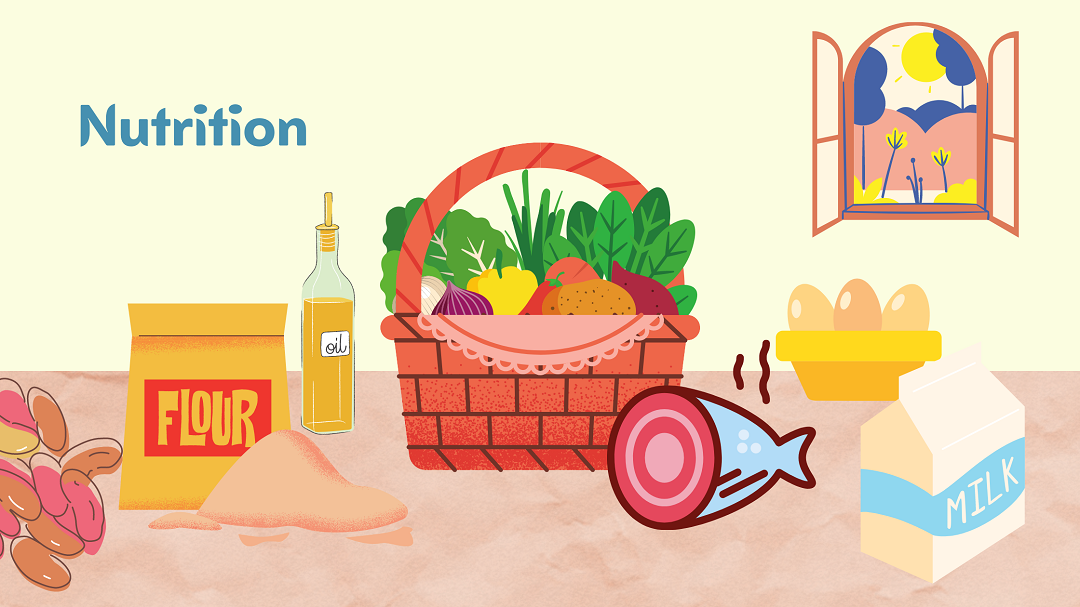Table of Contents
- The 6 essential nutrients your body needs and their functions
- The 11 essential vitamins and minerals your body needs
- The health benefits and primary functions of these vitamins are –
- How to eat for your goals (health, fitness) and why one should focus on changing one’s body composition rather than losing or gaining weight
- How to find your body composition and is BIA safe
- How diet and exercise work together
- For people who want to gain weight
- How should both groups eat
- Carbohydrates
- Fats
- Proteins
- Water
- Antagonism and Synergism in Nutrition
- A general direction for a healthy diet
- Conclusion
Nutrition is a topic that is shrouded in mystery and clouded by misconceptions on multiple levels.
People are bombarded by new research on nutrition, fads, and diets every day that seems to be a perfect fit for someone’s need.
When it comes to fitness or eating right people often seem to be looking for the missing puzzle or a radical regime that will get them their desired results quickly.
Even when I hear about the advice that my friends get from their nutritionist I often see them promoting the same radical steps that give their clients an illusion of professional consultation that prescribes steps to fitness that are out of the ordinary because the ordinary somehow feels incompetent to the consumer and unworthy of paid help.
If all I have to do is eat the right type of carbs at the right time, have sufficient protein in my diet, consume good fats, and ensure a steady supply of natural vitamins and minerals, with a little bit of exercise for good health, then why do I need a professional that charges 2 to 3 digits of fees every session?
For most people, sure yes! The above advice is amply sufficient but in some specialized cases, like for people with food allergies and intestinal disorders, a little more specific prescription is required.
Bodybuilders and models also fall into the special category but for most people, even those that just want to look fit, a basic understanding of food and nutrition is enough and with that, they can do wonders for their body.
In this post, we will be going over the six essential nutrients our body needs, their functions, and how to consume them properly.
We will also shun away some common misconceptions about them and so let us begin.
The 6 essential nutrients your body needs and their functions
An essential nutrient is something that we have to take from outside the body. Our primary nutrient source is food and food can be categorized into 6 different classes that comprise our entire nutrition.
The 6 nutrients are:
- Carbohydrates
- Lipids (fats and oils)
- Proteins
- Vitamins
- Minerals
- Water
The bulk of our diet is made up of carbohydrates, fats, and proteins. These 3 macronutrients serve as the main raw material that is used to fuel, build and maintain our body. The multitude of physiological and metabolic processes that sustain life are carried out with the help of these 3.
In contrast to them are the micronutrients which do not generate energy on their own but are the facilitators that are required to facilitate various metabolic processes throughout our body.
Micronutrients are only required in milligrams in comparison to the grams that macronutrients are consumed in.
The 11 essential vitamins and minerals your body needs
Vitamin A, B Vitamins, Vitamin C, Vitamin D, Vitamin E, Vitamin K, Folic Acid, Calcium, Iron, Zinc, and Chromium are the 11 essential vitamins and minerals our body needs.
Some of them are fat-soluble and some of them are water-soluble. Water-soluble vitamins are quickly excreted through urine and rarely accumulate to toxic levels whereas fat-soluble vitamins can get stored to toxic levels.
One interesting thing about fat-soluble vitamins is that we do not necessarily need to consume them daily. As long as the average intake of them over weeks, months, and even years meets the body’s needs we are good to go.
While there are a couple of other details surrounding them I am just giving you the most basic of the things that you need to understand what constitutes a healthy diet and how nutrients shape our well-being.
The health benefits and primary functions of these vitamins are –
- Keeps the immune system healthy
- Maintains healthy skin
- Helps the body metabolize proteins and carbs
- Boosts healing
- Supports brain and nervous system functioning
- Supports calcium absorption
- Supports bone formation and improves bone health
- Balances water level in the body
- Acts as an antioxidant
- Help keep the blood oxygenated
- Keeps our body tissues healthy
- Aids muscle contraction and relaxation, protects the vision, keeps the lungs and gastrointestinal tract healthy, etc.
Similar to vitamins, minerals are essential for many bodily functions like regulating our metabolism, keeping us appropriately hydrated, wound healing, and hormone creation.
If you look at it these are all the things that make life possible and dictate the quality of our health and so our life.
Even though micro, these nutrients are very important.
How to eat for your goals (health, fitness) and why one should focus on changing one’s body composition rather than losing or gaining weight
When most people visit a nutritionist or think of nutrition they are thinking in macros and net weight loss or gain rather than fine-tuning the body. BMI is also a wrong indicator of health because it doesn’t account for the body composition of a person and merely determines a healthy weight ratio by taking into account the height-to-weight ratio.
A person with more lean mass might weigh more than someone who is visibly overweight because muscle takes up less space than fat and weighs more than it.
When losing weight a person might be losing his muscle mass as well which isn’t an ideal scenario and even when someone is trying to gain weight they might gain it by methods that create an imbalanced body composition. Too little fat mass in skinny people isn’t ideal either, on a critical level fat is essential for healthy brain function.
An imbalance in body composition merely puts up a show but doesn’t account for being healthy or fit.
There needs to be a balance and for that, one must understand what body composition is and how to eat and train for it.
Our body composition is made up of 4 components: Fat, Protein, Minerals, and Body water.
Body composition analysis can more accurately determine your overall health and fitness.
There is healthy fat mass to lean body mass ratios for every gender and age group which broadly ascertains that you are at least physically fit.
Generally less fat mass and more lean mass which comprises of muscle, bone, organs, and fluids broadly speaking, is considered a healthy body composition.
When trying to change your body composition, you won’t have a singular goal like losing weight or gaining muscle but you will have two clear goals:
- Reduce Fat Mass
- Increase Lean Body Mass
To achieve that, however, eating right is not the only thing you will have to do, you will also have to work out a little as well.
How to find your body composition and is BIA safe
There are many advanced and sophisticated ways to measure body composition like Hydrostatic Weighing, Air Displacement Plethysmography (ADP), and Dual-energy X-ray absorptiometry (DXA or DEXA) but these require professional intervention and incur a lot of costs.
Then there are calipers you can use to get a somewhat accurate reading of your body composition but this method is largely prone to human error and it’s cumbersome to do.
The most accessible and marginally or at least virtually accurate method of measuring body composition is by using a bioelectrical impedance analysis device.
If you ever had a fitness trainer at a gym and he/she made you stand on a machine bare feet while holding some extension of the machine in your hands and then gave you a report of your body then you have experienced how a BIA machine works.
The machine passes small currents through your body while analyzing it and infers the amount of fat present in your body by measuring something else like water.
These devices are considered safe for most people but people who have any electronic implants and pregnant women should not use them.
Consumer BIA scales differ in quality and accuracy because not all devices test the entire body. Some scales only measure leg impedance and determine results for the upper body with the help of estimations and formulas and some handheld ones only measure arm impedance and make estimates for the lower body.
However as these scales offer a variety of features at a reasonable cost and are a quick and easy way to determine your body composition, they are a worthwhile investment for any consumer.
Medical-grade BIA devices can provide measurements closely accurate to the gold standard procedures but again they are not as readily accessible.
Therefore investing in a home consumer line BIA device is a thoughtful investment for your health and fitness.
If you are a reader from the US, you can purchase a BIA device from Amazon by clicking here.
How diet and exercise work together
People who want to lose weight, need to increase their BMR (Basal metabolic rate) which is the rate of energy expenditure of your body at rest. When you start working out and eat a balanced diet you start gaining muscle, and muscles naturally burn more calories, which means they require more fuel than fat or any other bodily function, resulting in a higher calorie expenditure over time and aiding fat loss.
If you noticed, I said gaining muscle and losing fat. You are losing fat but not necessarily weight, you might see the same number on the scale but start looking fitter in the mirror. That’s true fitness.
Don’t worry if your numbers suddenly go up but in the mirror, you appear fitter. That’s progress.
A lot of people in such a scenario suddenly have even less food and start exercising more. This results in an absurd calorie deficit that switches our body into starvation mode, which slows down our metabolism for conserving energy, catabolizing muscle if required for fuel, opposite of what we set out to do, and starts hoarding fat for an unrealistic drought. It is our body’s survival mechanism into action.
If you are feeling sluggish or hungrier because of your fitness routine and diet then this could be the reason.
Recalibrate your regime both in terms of exercise and diet to balance your body’s functions and composition.
The simple math is that if you want to lose weight in a healthy range you should eat 500 calories less than your BMR and if you healthily want to gain weight then eat 500 extra calories than your BMR. Eat more than you require you will gain weight. Eat less than you require you will lose weight.
If you are trying to build muscle a different logic will be applied but that is for another day.
If you don’t have an expert to aid you then you can calculate your BMR using this online calculator. It might not be 100% accurate but it will help you get enough idea by the means of which you can tweak your diet and exercise properly. Please note, choose the BMR number based on your lifestyle and activity levels and not just the number of calories you require at rest.
Eating right rather than eating less is the practical way of achieving fat loss or fitness as a whole.
Always aim for fat loss and not weight loss.
For people who want to gain weight
Doing aerobics and cardio exercises are good for toning muscle and burning fat but not necessarily suggested for gaining weight. People aiming to lose fat should also use them appropriately rather than overdoing them, which is the case most often.
Rather both the groups, skinny and fat, should focus on strength training and weight lifting for gaining or losing weight because it builds muscles and redoes the composition of our body.
It also starts suggesting the body to use the consumed energy productively rather than burning it away unnecessarily in case of skinny people and storing it unnecessarily in case of the overweight.
That doesn’t mean however those skinny people should entirely leave out doing cardio. It’s a good means to cardiovascular fitness and should be incorporated in a workout regime methodically to maintain it.
Skinny fat is a common phenomenon and therefore it is more dangerous than visibly fat people whose body readily displays unhealthiness. “I see these people all the time,” says Dr. Daniel Neides, medical director at Cleveland Clinic’s Wellness Institute and Chanatry’s doctor. “On the outside, they look incredibly healthy, but on the inside, they’re a wreck.” You likely know someone who’s “skinny fat.”
So, health should be the focus rather than just the look because looks could be deceiving. It’s not just about being skinny or fat but it’s about how your body is composed and how fit it actually is.
How should both groups eat
For both groups, there are going to be some rules of thumb and some exceptions, all healthy individuals with no disorders or health issues will benefit from the rules of thumb and as for the exceptions I encourage you to do your research after you get to know about the direction here.
Also please bear in mind this is no expert advice but rather an educated suggestion.
I have worked on my body and studied the effects of various lifestyles on my friends and family and have derived some educated conclusions from what I studied online while attempting to build my own body.
Now, one basic thing is that most foods provide a mixture of energy supplying nutrients, vitamins, minerals, and water. Two exceptions are table sugar and vegetable oil which are virtually pure carbohydrate (Sucrose) and Fat, respectively.
Carbohydrates
Carbohydrates are our main source of energy and they provide 4 calories of energy per gram. There are two main types of carbohydrates, simple carbohydrates, and Complex carbohydrates, both groups naturally benefit from eating complex carbohydrates. Complex carbohydrates give a sustained flow of energy and therefore help an individual to neither feel depleted nor store fat because of a sudden surge of energy.
Contrary to popular belief, only a few studies claim that a diet rich in healthy carbohydrates leads to weight gain or obesity. Low-card diets are normally not advisable, they are detrimental to learning, memory, and thinking.
Choose whole-grain foods rather than refined ones because refined grains go through a process that strip out parts of the grain that contain B vitamins and other important nutrients.
In countries like India obtaining and eating whole grain foods is a cultural phenomenon but now even there large metropolises see an influx of factory-made flour because of the fast-paced lifestyles there that discourage fetching freshly ground flour.
As a lifestyle choice, individuals can limit the consumption of simple carbohydrates, like white bread, pasta, rice, and sugar but for skinny individuals who are aiming to gain weight, not sugar but other simple carbohydrates can be a jolt of energy after a busy day or a hard workout to ensure instant supply of energy and negate catabolism.
Fats
People avoid eating fats like the plague when they are trying to get fit and they should be, considering that one gram of fat contains 9 calories, which is more than any other nutrient but again this is another misconception.
No one gains body fat because you consume a lot of oils, butter, and fatty foods, you gain body fat because of excess calories obtained from any source of food.
The weight gain and weight loss math are simple.
If you want to gain weight then you should consume more calories over time than you burn off and if you want to lose weight then you should consume fewer calories than you need. As simple as that.
So fat isn’t the culprit here because it’s mainly the number of calories you eat that matters depending upon what you are trying to achieve.
Healthy fats are extremely important in your diet because they support many of your body’s essential functions like vitamin and mineral absorption, muscle movement, brain function, immune response, regulation of hormones, and blood clotting.
Healthy fats also act as anti-inflammatory compounds.
Without the right amount of fat in your body, you are making it susceptible to a lot of imbalances that could greatly hamper your overall performance and health.
As a rule of thumb, trans fats should be avoided, saturated fats should be consumed in moderation and monounsaturated and polyunsaturated fats should be welcomed in your diet. Good sources of fat can be identified by reading the labels and by understanding how they act at room temperature.
The two main types of polyunsaturated fats are omega-3 fatty acids and omega 6-fatty acids. These are essential fatty acids because they cannot be synthesized in the body. You can obtain these from either fatty fish or plant sources like flaxseeds.
Healthy fats are essential for your body and they can also aid fat loss. So, keep in mind fats are not bad but they are essential. It’s just the source that needs to be good.
Proteins
Proteins are extremely important, not just for building muscles but for the overall growth, maintenance, and sustenance of the body. Everything you see in the mirror is protein, every cell in your body is made up of protein, your bones, hair, etc. Everything is protein.
A whopping 16% of an average person’s body weight is made up of protein.
Antibodies, hormones, collagen, connective tissues, and other important substances are composed of protein.
Protein simply serves as the basic structural material of the body.
Something so important cannot be simply absent or present minimally in your diet.
For health and fitness, having the bare minimum required amount of protein in your diet is necessary.
A daily intake of 0.75 grams of good-quality protein per kilogram of body weight for adults of both sexes is recommended by the World Health Organization. A 70-Kg (154 pounds) man would need 52.5 grams of protein, and a 55-Kg (121 pounds) woman would require 41 grams of protein. A lot of bodybuilding websites or experts advise 1 gram of protein per pound of body weight but in my opinion that would be overkill if you are activity level is not at par with that intake or you are not specifically looking forward to putting on a lot of muscle mass.
If you are fairly active, then add 10 grams of protein to the WHO’s recommendation and I think you will do just fine.
Protein is rarely used as a fuel source for the body. Only during a state of starvation, fasting, or insufficient intake of protein, lean tissue is broken down to supply amino acids for the vital functions of the body.
People looking to put on at least some muscle mass and those aiming to gain weight shouldn’t let such a condition arise by ensuring adequate consumption of protein.
Protein also takes longer to digest and therefore burns additional calories while being digested and aids fat loss. The lean tissue growth it supports later boosts fat loss further.
This is a double-action macronutrient that should be paid attention to by any person who wants to get fit.
Proteins are made up of Amino acids and our body requires a variety of them to function properly. There are 9 essential amino acids that our body needs which can only be obtained from food and cannot be synthesized in our body.
Foods of animal origins – Eggs, Dairy Products, Meat, and Fish are high-quality and complete sources of protein. Their amino acid profile matches human requirements precisely. Plant-origin foods are considered lower quality or incomplete proteins, except for soybeans, because of their incomplete amino acid profile, which is important for synthesizing the protein properly in the body.
However, a good thing is that you don’t require to eat all the amino acids at the same time. Your body is quite smart and it creates complete proteins from the foods you eat throughout the day. It essentially completes amino acid profiles by matching independent amino acids from different foods.
As a vegetarian myself even I got worried initially when I got to know about the incompleteness of vegetarian protein sources. However, if you eat a varied vegetarian diet and the amino acids of the protein-containing foods complement each other then you can be sure that you will experience the benefits of complete proteins.
Giving a broad example, if you eat legumes such as beans and consume some rice with it or later in the day, then their joint amino acid profile will complement each other and provide a higher quality protein than either of the food would do alone.
This is known as synergism in nutrition about which we will read a little more in the article ahead.
There are also two other types of dietary proteins called Casein and Whey. Each has its own usefulness and you can read more about them here in this article about the good sources of protein.
So, while everyone must have told you proteins are essential, now you know why they are important.
Water
As we all know, we can survive weeks without food, but we can die without water in just a couple of days. Water is a highly overlooked yet the most important nutrient out there.
The movement of nutrients and waste matter in our bodies becomes possible because of water. Water is the medium in which all the biochemical reactions of metabolism occur. Water regulates our body’s temperature, blood volume, pressure, and rigidity of our body’s tissues to name its important functions.
Digestion and shock absorption are also a function.
Dehydration can hamper memory and our body’s overall performance, death is its most severe outcome.
And so no matter how savvy or choosy you are, no soda, juice, or wine can replace or substitute the role of plain water, and therefore in all sincerity, it must be consumed religiously and as required.
Antagonism and Synergism in Nutrition
When two are more nutrients work together to generate health benefits greater than the sum of the individual nutrients then such a phenomenon is called nutrient synergy.
We read about it concerning the combined amino acid profile of beans and rice and another example is that vitamin D enhances the absorption of calcium in the gastrointestinal tract. And so the sun is important for strong bones and immunity.
Antagonism is the opposite of this, it’s when two or more nutrients interact to produce a lesser effect than the sum of their individual effects.
A common example would be the consumption of tea after consuming protein. Tea hardens the protein present in our diet making it difficult for our body to absorb.
A general direction for a healthy diet
Now after learning about the nuances of the 6 essential nutrients our body needs, how they function in our body, what body composition is, and how to use it to create a fit and healthy body, we can clearly understand that just eating a well-balanced diet comprising of all these nutrients is enough, along with some working out to get truly fit and look fit.
A person needs to consume all six types of essential nutrients to ensure good health as these nutrients support vital functions of our body like growth, immunity, and maintenance of the CNS.
Don’t avoid or eat in excess any foods for the sake of it and because you have heard about their so-called benefits from someone.
Always ensure that your diet has enough calories to support your BMR and the goal you are trying to achieve, no less or no more, include lean proteins, vegetables, fruits, healthy fats, and water in your diet.
They are essential without a doubt.
A varied colorful diet will also ensure that you get all the necessary micronutrients for the growth and sustenance of your body.
You don’t have to overthink or overanalyze what you are eating. Just keep all the things you have learned in this article about diet and nutrition, coupled with information on exercise, body composition, and BMR in mind, and incorporate them into your lifestyle as it suits you best.
Additionally, ditch excess sugar and sugary foods, say no to processed foods, and minimize junk food in your diet.
Organic foods can also be given special consideration.
There’s no need to abstain from anything, just ensure that you are not overdoing anything. That’s the way to a healthy life and a healthy lifestyle.
Fitness this way will become intuitive rather than a barrage of fads and confusion.
Extreme diets like Paleo and Keto are therefore in a way unsustainable and unsuitable for an everyday individual.
To meet your fitness goals you don’t need their help. Such extreme diets may cause more harm than good in the long run and therefore one should not go their way to experience faster results.
A holistic approach to nutrition and fitness is any day better. It’s also sustainable. For you and the environment.
Conclusion
A healthy and fit body doesn’t just look great but it also performs great. Even though I covered this article from the point of people who want to lose or gain weight, because that’s the most of us, the application of the information presented in this article is not just about that.
It’s about understanding that eating right is very intuitive, sustainable, and simple.
Sure you would need to make some changes to your everyday diet but they won’t be as drastic as many people think of it when they think about eating healthy.
Some common misconceptions about fat and carbohydrates were dismissed as well. There are only two really though, that the consumption of them leads to fat gain. This is not true, it simply depends upon the number of calories in and calories out.
Learning about BMR and Body Composition also must have helped you understand how to ascertain your fitness goals.
Briefly, I also described what kind of workout and exercise you should do. On that note, I would also encourage you to check out the article on Pranayama on Soulo.
Taking everything mentioned in this article you can readily start applying it and becoming fit and you can also use it as a compass and do your own research to truly fine-tune your efforts.
When you do these things right, your concentration improves, your memory becomes sharper, you feel energetic, motivated, and full of life, and physical strength gets translated into mental strength and together both of them can help you do more and be more in life.
Think about it. It’s really simple.








